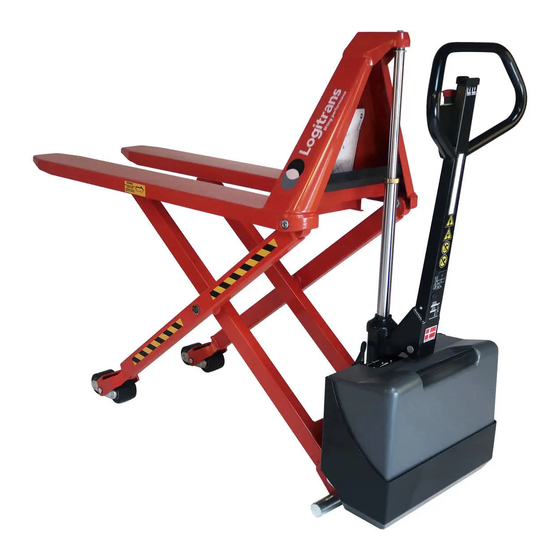
Summary of Contents for logitrans EHL 1004
- Page 1 Instruction Manual Instruction Manual Instruction Manual Instruction Manual Instruction Manual Maintenance EHL 1004 EHL 1004 EHL 1004 EHL 1004 EHL 1004...
- Page 2 1.0 Before the first lift... The highlifter is manufactured in accordance with safety directives. Among the subjects dealt with in this Instruction Manual are: - Proper application - Physical limitations of the product - Risks with improper use Therefore please read this Instruction Manual carefully!
-
Page 3: Battery Specifications
2.0 There must be a current supply 2.1 Battery specifications The manufacturer offers three different battery types recommended for EHL 1004: Semi-trak Tubular cell Maintenance free 986034 986024 986040 Voltage 12 V 12 V 12 V Capacity 60Ah/5h 56Ah/5h 50Ah/5h... -
Page 4: Checking The Battery
2.2 Checking the battery Method A for SEMI-TRAK and TUBULAR CELL: Check acid density in the six battery cells with an acidometer. Check each cell - max. difference between each cell 0.04 kg/l. DENSITY 1.26 - 1.28 kg/l Fully charged 1.19 - 1.20 kg/l 1/2 charged 1.16 - 1.17 kg/l... -
Page 5: Battery Indicator
2.5 Battery indicator The battery indicator shows the battery charge in %. The most accurate reading can be obtained after the battery has been allowed to remain idle for 5-10 minutes. Yellow: Battery capacity: 25%-50% The battery can still be used; charging is recommended. -
Page 6: Emergency Stop
Replacement: Before replacing fuse, disconnect battery + pole. The old fuse can then be removed and replaced by a new one of the same size. Do not insert a larger fuse; the fuse acts as a protector for the pump motor. Find out why fuses blow! B: Safety/pressure relief valve: protection against mechanical and hydraulic overload. -
Page 7: Oil Change
3.0 Long live the highlifter Regular inspection and the replacement of worn or defective parts in good time will prolong the life of the highlifter. "Prevention is better than repair", therefore ensure: - Correct usage - Regular cleaning - Periodic service inspection 3.1 Lubrication and oil change Under normal operating conditions the highlifter requires no lubri- cation. -
Page 8: Bleeding The Hydraulic System
3.3 Cold and humid operating conditions affect the oil! Oil becomes thicker as it becomes colder. Therefore avoid allowing the highlifter to stand unused in the cold.In severe cold, water in the hydraulic system can condense, with breakdown of gaskets and oil as a consequence. The highlifter will lower more slowly when the oil is cold.The oil is suitable for use in the temperature range -10 to +50°C. - Page 9 4.0 Fault location key When the HIGHLIFTER is used every day, adjustments and the replacement of worn parts might be necessary. If a fault appears during daily operation of the highlifter, first check: Oil supply Electricity supply Condition of leads and fuses If faults cannot be traced to these sources, contact your dealer, but ..
- Page 10 Cause Mending See point 3.1 / 3.2 Oil deficiency Battery discharged See point 2.3 Fuse blown See point 2.6 See point 2.7 Leads defective Max. load exceeded See point 2.6 Air in hydraulic system See point 3.4 Pressure relief valve incorrectly Contact the adjusted distributor...














Need help?
Do you have a question about the EHL 1004 and is the answer not in the manual?
Questions and answers